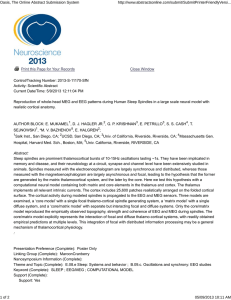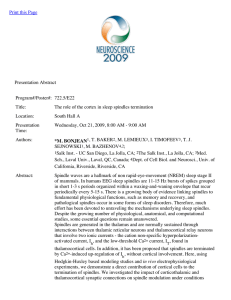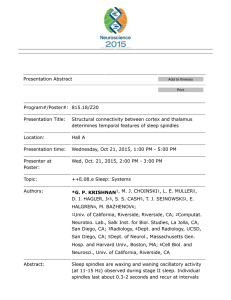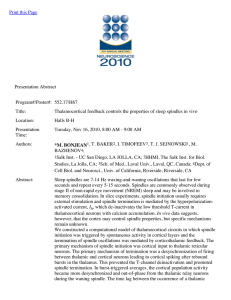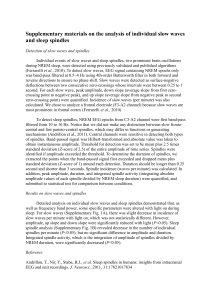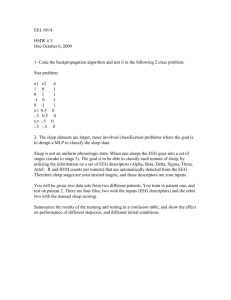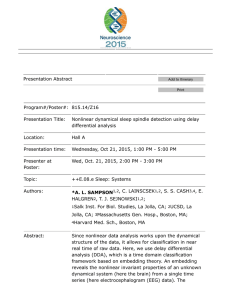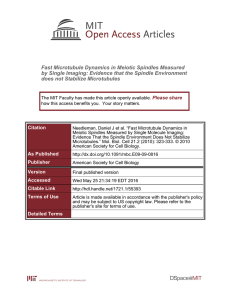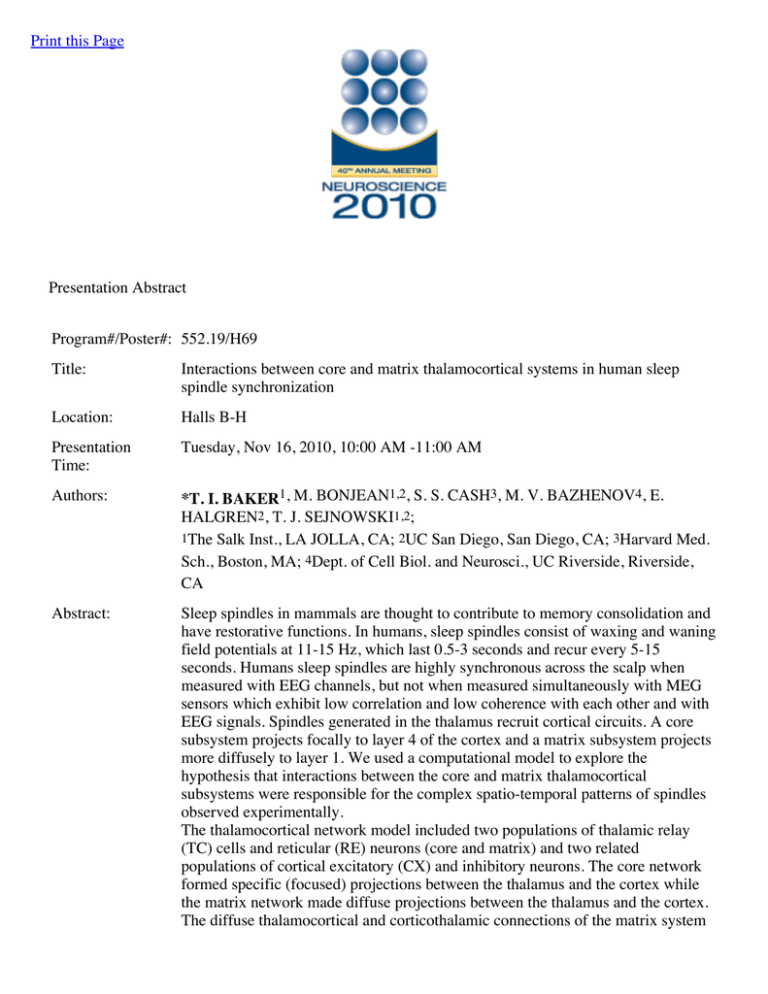
Print this Page
Presentation Abstract
Program#/Poster#: 552.19/H69
Title:
Interactions between core and matrix thalamocortical systems in human sleep
spindle synchronization
Location:
Halls B-H
Presentation
Time:
Tuesday, Nov 16, 2010, 10:00 AM -11:00 AM
Authors:
*T. I. BAKER1, M. BONJEAN1,2, S. S. CASH3, M. V. BAZHENOV4, E.
HALGREN2, T. J. SEJNOWSKI1,2;
1The Salk Inst., LA JOLLA, CA; 2UC San Diego, San Diego, CA; 3Harvard Med.
Sch., Boston, MA; 4Dept. of Cell Biol. and Neurosci., UC Riverside, Riverside,
CA
Abstract:
Sleep spindles in mammals are thought to contribute to memory consolidation and
have restorative functions. In humans, sleep spindles consist of waxing and waning
field potentials at 11-15 Hz, which last 0.5-3 seconds and recur every 5-15
seconds. Humans sleep spindles are highly synchronous across the scalp when
measured with EEG channels, but not when measured simultaneously with MEG
sensors which exhibit low correlation and low coherence with each other and with
EEG signals. Spindles generated in the thalamus recruit cortical circuits. A core
subsystem projects focally to layer 4 of the cortex and a matrix subsystem projects
more diffusely to layer 1. We used a computational model to explore the
hypothesis that interactions between the core and matrix thalamocortical
subsystems were responsible for the complex spatio-temporal patterns of spindles
observed experimentally.
The thalamocortical network model included two populations of thalamic relay
(TC) cells and reticular (RE) neurons (core and matrix) and two related
populations of cortical excitatory (CX) and inhibitory neurons. The core network
formed specific (focused) projections between the thalamus and the cortex while
the matrix network made diffuse projections between the thalamus and the cortex.
The diffuse thalamocortical and corticothalamic connections of the matrix system
helped synchronize neural firing leading to more synchronous activity in the
superficial cortical layers, as observed experimentally. In a previous study we used
a coherence measure for traveling waves. In this study the synchrony measure was
an all-to-all, zero-time-lag cross correlation of the estimated LFP related to the
Schreiber reliability measure. Furthermore, two distinct populations of RE neurons
allowed spindles to be independently initiated in the core and propagated to the
matrix with a systematic delay of hundreds of milliseconds after the core. In both
core and matrix subsystems the TC cells fire at 5-6 Hz with the RE and CX cells
active at double this frequency, 10-12 Hz. Relative synchrony of spindle
oscillations between core and matrix networks depended on the pattern of
intracortical connections between the networks. Our results suggest that the
differential activity patterns in the core and matrix thalamocortical network may
explain discrepancies between the temporal patterns of spindles simultaneously
observed in EEG and MEG recordings. This is consistent with the hypothesis that
EEG recordings are sensitive to the cortical spindle activity in the superficial
layers generated by the matrix subsystem while MEG recordings reflect spindle
components in the deep layers generated by the core subsystem.
Disclosures:
T.I. Baker: None. M. Bonjean: None. S.S. Cash: None. M.V. Bazhenov:
None. E. Halgren: None. T.J. Sejnowski: None.
Keyword(s):
synchronization
sleep spindle
oscillations
Support:
NIBIB
NINDS
HHMI
Crick-Jacobs Center
[Authors]. [Abstract Title]. Program No. XXX.XX. 2010 Neuroscience Meeting
Planner. San Diego, CA: Society for Neuroscience, 2010. Online.
2010 Copyright by the Society for Neuroscience all rights reserved. Permission to
republish any abstract or part of any abstract in any form must be obtained in
writing by SfN office prior to publication.

